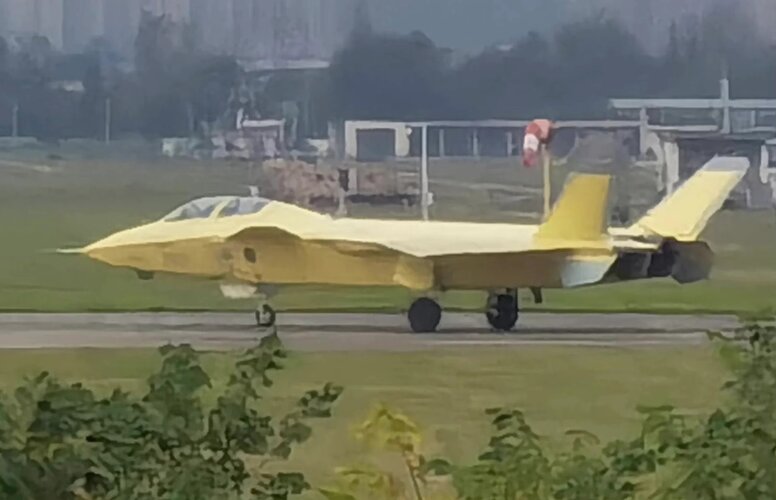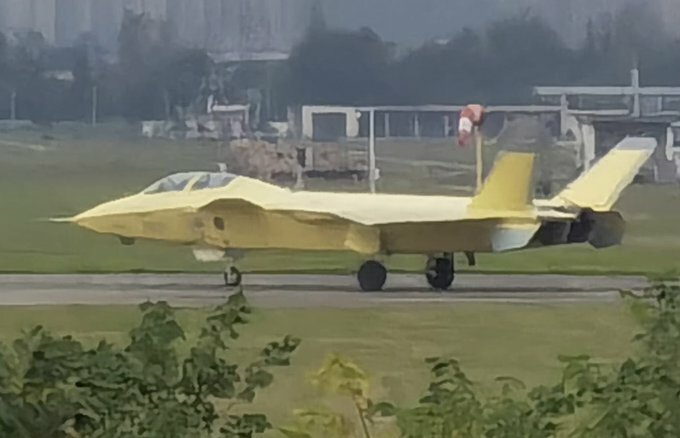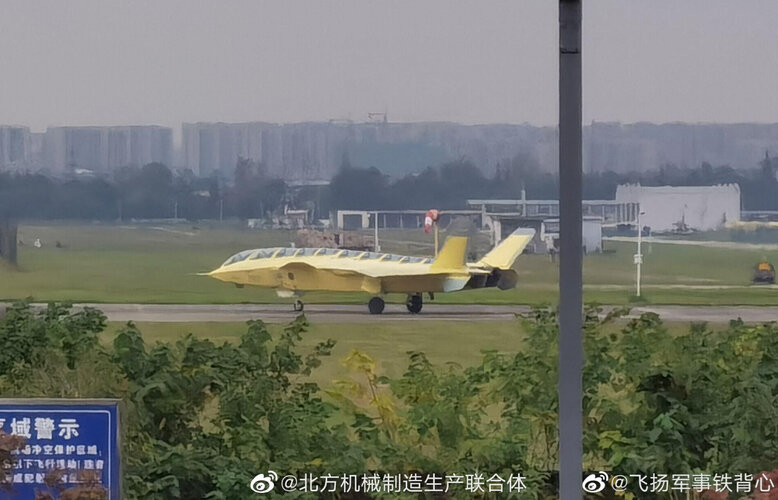You are using an out of date browser. It may not display this or other websites correctly.
You should upgrade or use an alternative browser.
You should upgrade or use an alternative browser.
Chengdu J-20 news and analysis Part III
- Thread starter overscan (PaulMM)
- Start date
FighterJock
ACCESS: Above Top Secret
- Joined
- 29 October 2007
- Messages
- 5,554
- Reaction score
- 5,860
But will it remain stealthy?!
I would hope that the J-20B will remain stealthy TomcatVIP, I could not imagine the J-20B not having some form of stealth coating.
Depends on the type of links to the UCAVs and their degree of autonomy.But will it remain stealthy?!
In_A_Dream
ACCESS: Top Secret
- Joined
- 3 June 2019
- Messages
- 669
- Reaction score
- 681
Depends on the type of links to the UCAVs and their degree of autonomy.
This.
- Joined
- 2 January 2006
- Messages
- 3,804
- Reaction score
- 4,950
Depends on the type of links to the UCAVs and their degree of autonomy.
This.
This?
- Joined
- 11 February 2010
- Messages
- 1,639
- Reaction score
- 2,662
Well Sferrin's point is that.
In order to control the UAV the aircraft has to emit. Datalink or communication has two kinds of antenna, a blade with wide beamwidth and a pencil beam highly directional antenna.
The wide beamwidth antenna may betray stealth as it radiates in practically all direction with equal strength (aka omnidirectional or -almost- omnidirectional). The pencil beamwidth one often works in high frequency have smaller and highly directional beam which can be steered electronically like phased array. The latter is preferred method as not only highly directional with controlled sidelobes which makes ESM life hard, higher signal strength and therefore bandwidth can be gained.
This highly directional communication beam can be generated from dedicated datalink antenna like MADL or be part of the radar's operating modes.
I would assume J-20 radar will include such mode. This allows transmission and reception of good quality high bandwidth signal from long range.
In order to control the UAV the aircraft has to emit. Datalink or communication has two kinds of antenna, a blade with wide beamwidth and a pencil beam highly directional antenna.
The wide beamwidth antenna may betray stealth as it radiates in practically all direction with equal strength (aka omnidirectional or -almost- omnidirectional). The pencil beamwidth one often works in high frequency have smaller and highly directional beam which can be steered electronically like phased array. The latter is preferred method as not only highly directional with controlled sidelobes which makes ESM life hard, higher signal strength and therefore bandwidth can be gained.
This highly directional communication beam can be generated from dedicated datalink antenna like MADL or be part of the radar's operating modes.
I would assume J-20 radar will include such mode. This allows transmission and reception of good quality high bandwidth signal from long range.
FighterJock
ACCESS: Above Top Secret
- Joined
- 29 October 2007
- Messages
- 5,554
- Reaction score
- 5,860
Well Sferrin's point is that.
In order to control the UAV the aircraft has to emit. Datalink or communication has two kinds of antenna, a blade with wide beamwidth and a pencil beam highly directional antenna.
The wide beamwidth antenna may betray stealth as it radiates in practically all direction with equal strength (aka omnidirectional or -almost- omnidirectional). The pencil beamwidth one often works in high frequency have smaller and highly directional beam which can be steered electronically like phased array. The latter is preferred method as not only highly directional with controlled sidelobes which makes ESM life hard, higher signal strength and therefore bandwidth can be gained.
This highly directional communication beam can be generated from dedicated datalink antenna like MADL or be part of the radar's operating modes.
I would assume J-20 radar will include such mode. This allows transmission and reception of good quality high bandwidth signal from long range.
If the J-20B were to have a link-16 type datalink I would think that it would use internal antenna something similar to what the F-22 has instead of external blade antenna that would degrade the J-20B's stealth capability.
latenlazy
I really should change my personal text
- Joined
- 4 July 2011
- Messages
- 245
- Reaction score
- 37
External blades can be integrated into surface edges.Well Sferrin's point is that.
In order to control the UAV the aircraft has to emit. Datalink or communication has two kinds of antenna, a blade with wide beamwidth and a pencil beam highly directional antenna.
The wide beamwidth antenna may betray stealth as it radiates in practically all direction with equal strength (aka omnidirectional or -almost- omnidirectional). The pencil beamwidth one often works in high frequency have smaller and highly directional beam which can be steered electronically like phased array. The latter is preferred method as not only highly directional with controlled sidelobes which makes ESM life hard, higher signal strength and therefore bandwidth can be gained.
This highly directional communication beam can be generated from dedicated datalink antenna like MADL or be part of the radar's operating modes.
I would assume J-20 radar will include such mode. This allows transmission and reception of good quality high bandwidth signal from long range.
If the J-20B were to have a link-16 type datalink I would think that it would use internal antenna something similar to what the F-22 has instead of external blade antenna that would degrade the J-20B's stealth capability.
Well Sferrin's point is that.
In order to control the UAV the aircraft has to emit. Datalink or communication has two kinds of antenna, a blade with wide beamwidth and a pencil beam highly directional antenna.
The wide beamwidth antenna may betray stealth as it radiates in practically all direction with equal strength (aka omnidirectional or -almost- omnidirectional). The pencil beamwidth one often works in high frequency have smaller and highly directional beam which can be steered electronically like phased array. The latter is preferred method as not only highly directional with controlled sidelobes which makes ESM life hard, higher signal strength and therefore bandwidth can be gained.
This highly directional communication beam can be generated from dedicated datalink antenna like MADL or be part of the radar's operating modes.
I would assume J-20 radar will include such mode. This allows transmission and reception of good quality high bandwidth signal from long range.
If the J-20B were to have a link-16 type datalink I would think that it would use internal antenna something similar to what the F-22 has instead of external blade antenna that would degrade the J-20B's stealth capability.
Link 16 equivalent as the primary datalink for a 5th generation fighter would be somewhat obsolete.
Higher bandwidth and more stealthy directional datalinks is the norm for 5th gens, like MADL and IFDL, which should already be present on standard J-20s anyhow as a requisite baseline capability.
The twin seater obviously would offer enhanced UAV control capability compared to the standard single seater, but imo the greater significance is one of generally significantly greater enhanced battle management and command capabilities, leveraging the aircraft's sensor suite, avionics and networking capability, which along with increased automation of modern aircraft (that's likely to further advance with time as well), can allow a twin seater J-20 to take on part of the AEW&C/airborne command post mission but in a far more survivable and distributed manner.
I.e. I see a twin seater J-20S as having the greatest effect for moving towards a more distributed AEWC capability in the long term. Though for now, obviously a twin seater J-20S will complement existing traditional AEWC capabilities.
alberchico
I really should change my personal text
- Joined
- 14 January 2014
- Messages
- 704
- Reaction score
- 1,506

This Is Our First Look At A Two-Seat Variant Of China's J-20 Stealth Fighter (Updated)
The arrival of the long-rumored two-seat 'J-20B' would signify a major boost to China's future air combat capabilities.
shin_getter
ACCESS: Top Secret
- Joined
- 1 June 2019
- Messages
- 1,092
- Reaction score
- 1,466
aonestudio
I really should change my personal text
- Joined
- 11 March 2018
- Messages
- 2,962
- Reaction score
- 7,466
- Joined
- 11 February 2010
- Messages
- 1,639
- Reaction score
- 2,662
Wow. Nice, really the first 2-seater 5th gen.
bloody sky
ACCESS: Confidential
- Joined
- 3 September 2021
- Messages
- 82
- Reaction score
- 87
FighterJock
ACCESS: Above Top Secret
- Joined
- 29 October 2007
- Messages
- 5,554
- Reaction score
- 5,860
Nice, really nice.
Last edited by a moderator:
A WSO or EW operator as a backseat can be very interesting, tactically.
FighterJock
ACCESS: Above Top Secret
- Joined
- 29 October 2007
- Messages
- 5,554
- Reaction score
- 5,860
I think that there could be a whole range of different future mission types for the J-20B, not just a UCAV controller with loyal wingman drones. Expect to see different designations in the near future.
In_A_Dream
ACCESS: Top Secret
- Joined
- 3 June 2019
- Messages
- 669
- Reaction score
- 681
I think that there could be a whole range of different future mission types for the J-20B, not just a UCAV controller with loyal wingman drones. Expect to see different designations in the near future.
Also serves as a nice R&D platform for other projects.
donnage99
ACCESS: Top Secret
- Joined
- 16 June 2008
- Messages
- 1,348
- Reaction score
- 832
its built for tourism purpose.The fatter J-20View attachment 666805[附件=完整]666790[/附件]
- Joined
- 17 October 2006
- Messages
- 2,393
- Reaction score
- 1,192
Managing UAS doesn't take a lot of bandwidth from the controller's end. "Sic 'im, Towser!"
Managing UAS doesn't take a lot of bandwidth from the controller's end. "Sic 'im, Towser!"
I think it depends on how many UAVs you are aiming to manage and also the sophistication of the UAVs in question, even with increasing automation. You still need a human being to take the information and options to make tactical decisions after all.
Also, the additional general battle management roles that the second human will be tasked with (which controlling UAVs is likely to be a subset).
If you want to manage a couple of dozen of stealthy UCAVs while also acting as battle management quarterback for dozens of manned fighters and supplementing traditional AEWC, all in a high end battlespace with heavy interference and large numbers of capable opfor aircraft, even automation and AI will still limit the number of tasks and decisions that a human being can make in a given time, acting as the rate limiting step.
- Joined
- 27 December 2005
- Messages
- 17,693
- Reaction score
- 25,995
Video is convincing. Better pic -
[removed - fake]
[removed - fake]
Last edited:
As Deino has noted, that looks to be a photoshop, as the prototype doesn’t have a gray radome.
- Joined
- 2 January 2006
- Messages
- 3,804
- Reaction score
- 4,950
Video is convincing. Better pic -
Indeed a faked one ... besides the radome, also the center frame of the canopy is wrong
FighterJock
ACCESS: Above Top Secret
- Joined
- 29 October 2007
- Messages
- 5,554
- Reaction score
- 5,860
Video is convincing. Better pic -
Indeed a faked one ... besides the radome, also the center frame of the canopy is wrong
Not again.
- Joined
- 27 December 2005
- Messages
- 17,693
- Reaction score
- 25,995
The video looked real.
The video looked real.
The video is definitely real.
the picture that was originally in post #909 was doctored however (and not a very good one at that), and it is that picture which Deino was referring to as fake.
FighterJock
ACCESS: Above Top Secret
- Joined
- 29 October 2007
- Messages
- 5,554
- Reaction score
- 5,860
The video looked real.
The video is definitely real.
the picture that was originally in post #909 was doctored however (and not a very good one at that), and it is that picture which Deino was referring to as fake.
So it was the picture that was the fake, I have been duped in the past with photo's allegedly showing the H-20 bomber. And now they (the photoshoppers) are at it again with the J-20B.Damn them.
- Joined
- 2 January 2006
- Messages
- 3,804
- Reaction score
- 4,950
The video looked real.
The video is definitely real.
the picture that was originally in post #909 was doctored however (and not a very good one at that), and it is that picture which Deino was referring to as fake.
So it was the picture that was the fake, I have been duped in the past with photo's allegedly showing the H-20 bomber. And now they (the photoshoppers) are at it again with the J-20B.Damn them.
Sorry for my confusing explanation ... only the very clear side view was fake, this one is surely real:

FighterJock
ACCESS: Above Top Secret
- Joined
- 29 October 2007
- Messages
- 5,554
- Reaction score
- 5,860
Same here Deino, keep up the good work. It must be hard trying to get good information the latest Chinese Military Aviation projects, and to filter out which is real and which is fake.
red admiral
ACCESS: Top Secret
- Joined
- 16 September 2006
- Messages
- 1,784
- Reaction score
- 2,315
So I'm assuming that because the primer goes all the way to the nose there is no radome and hence no radar and so this will probably be a flight sciences prototype to evaluate air vehicle performance and flying qualities?
In_A_Dream
ACCESS: Top Secret
- Joined
- 3 June 2019
- Messages
- 669
- Reaction score
- 681
Does the rear seat include an ejection apparatus? Looking at the canopy... looks a little tight going up, lol. Probably just image skewing.
jsport
what do you know about surfing Major? you're from-
- Joined
- 27 July 2011
- Messages
- 7,708
- Reaction score
- 5,708

New variants of Chinese stealth fighters break cover
Two new variants of China’s stealth fighters have broken cover in the past three days, including China’s next carrier-based fighter, hinted at during a recent air show.
Manuducati
ACCESS: Secret
- Joined
- 25 November 2020
- Messages
- 327
- Reaction score
- 1,054
(Picture removed, another fake one, sorry)
Last edited:
In_A_Dream
ACCESS: Top Secret
- Joined
- 3 June 2019
- Messages
- 669
- Reaction score
- 681
What is real? The canopy beam keeps changing. Details...Credits on pic.
(Yeah I don't speak Chinese neither but I forgot to save the link to the article)
- Joined
- 2 January 2006
- Messages
- 3,804
- Reaction score
- 4,950
Credits on pic.
(Yeah I don't speak Chinese neither but I forgot to save the link to the article)
Sorry to disappoint you, but this image was already posted a few pages before and is a faked on.
- Joined
- 2 January 2006
- Messages
- 3,804
- Reaction score
- 4,950
As it seem, it is indeed true, the J-20B prototype serial numbered 2031 performed its maiden flight today. So congrats again to CAC.
(Image via @siegecrossbow/SDF)


(Image via @siegecrossbow/SDF)


siegecrossbow
I really should change my personal text
- Joined
- 12 March 2012
- Messages
- 705
- Reaction score
- 2,097
As it seem, it is indeed true, the J-20B prototype serial numbered 2031 performed its maiden flight today. So congrats again to CAC.
(Image via @siegecrossbow/SDF)


First J-20 demonstrator: 2001
First J-20 prototype: 2011
First J-20 prototype using WS-10 engines: 2021
First twin-seater J-20: 2031
First WS-15 equipped J-20: ????
Similar threads
-
Shenyang FC-31 demonstrators / J-35 naval fighter / J-35A land-based version
- Started by Foxglove
- Replies: 993
-
-
-
-


